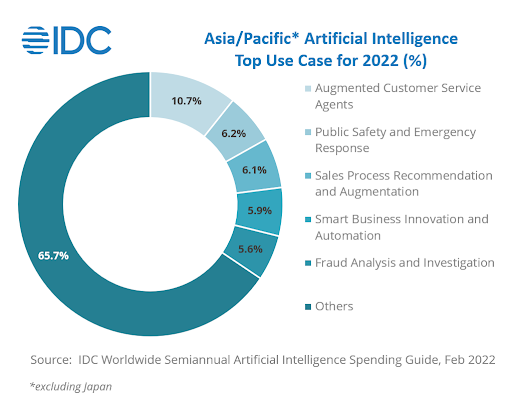Empowering Small Governments: How AI Can Help With Capacity Challenges and Effective Governance
May 2025
Governments are constantly being stretched thin when it comes to their capacity. This is especially true for small Pacific island nations. Hiring more government workers is of course an option, albeit an expensive and time-consuming one that would not necessarily address complex issues facing small countries. Thankfully, leveraging artificial intelligence could be the saving grace for developing nations like Vanuatu, and actually drive them forward into a significantly improved future.
The Unique Challenges of Small Governments
Small governments like Vanuatu face challenges that larger and more developed nations do not, even as Vanuatu has recently moved out of the Least Developed Countries category like its Pacific neighbor Samoa.
While the Asia-Pacific region continues to increase its funding for AI integration and implementation, so too should developing Pacific island nations if they want to leverage the many benefits this emerging technology provides.
These are some leading pain points for small and developing nations that can be ameliorated through the implementation of AI in government departments and ministries. Here are the most common challenges faced by small governments:
Limited Resources
There are limited budgets, few employees, and often inadequate infrastructure, making it challenging to address complex issues effectively.
Lack of Expertise
Accessing specialized expertise is a struggle, especially when it comes to areas of policy development, data analysis, and technology implementation.
Limited Data Access
It is often difficult to collect, manage, and analyze relevant data due to recurring resource constraints or use of outdated systems.
Administrative Burden
A small government will typically handle multiple administrative tasks using a limited workforce, leading to delays and wide-ranging inefficiencies.
Difficulty in Decision-Making
Small governments lack the necessary tools and resources to make proper data-driven decisions and evaluate the impact of their policies effectively.
Limited Public Engagement
Engaging citizens and receiving their feedback and input proves to be quite challenging for small governments due to their being limited communication channels and resources, and when they do exist it is a tedious process to engage with.
How AI Can Help Address These Pain Points
Given the challenges small governments face, it could be overwhelming to tackle and remedy them all. However, it is possible to make significant improvements with the use of existing AI tools and systems. Here are several ways AI can help small governments after the implementation of AI in government departments and ministries:
Automation & Efficiency
AI technologies are very good at automating repetitive administrative tasks. This helps small governments streamline processes and allocate resources more effectively, as well as reduce costs.
In more specific terms, here are some examples of how AI tools and systems can help automate and increase efficiency across various public sector domains:
Administrative Tasks - Automate routine admin-related tasks like data entry, document processing, and record keeping, thereby reducing staff workload and errors.
Workflow Optimization - Algorithms can analyze workflows and identify where bottlenecks and inefficiencies exist, as well as suggest improvements and automate steps that help streamline processes.
Resource Allocation - AI can help with optimizing resource allocation in areas like budgeting, analysis of historical data, trend forecasting, and recommendations for optimal allocation strategies based on a range of variables.
IT Operations - AI can be used to automate monitoring, maintenance, and troubleshooting of IT infrastructure, as well as to improve system performance to reduce downtime.
Regulatory Compliance - AI tools can help with automating compliance monitoring, flagging potential violations, and ensuring that regulations and policies are being adhered to.
Disaster Response - Disaster management can be supported by AI systems and tools by automating emergency response systems, analyzing real-time data, and providing both timely alerts and recommendations to mitigate the impact of disasters.
Infrastructure Maintenance - Monitoring and maintenance of infrastructures, including roads, bridges, and utilities, can be monitored by AI to detect anomalies, predict maintenance needs, and optimize maintenance schedules.
Data Analysis & Insights
Small governments will find that AI can assist them in analyzing large volumes of data very quickly, allowing them to extract valuable insights and identify patterns or trends that could assist in policymaking.
Some AI-powered data analysis examples are:
Data Processing - AI algorithms are able to efficiently process and analyze massive amounts of data, which allows small governments to gain valuable insights, identify patterns, and make data-driven decisions more effectively. Missing values, outliers, and inconsistencies in data can be easily identified to ensure quality and reliable data.
Predictive Analytics - It is possible to build predictive models using AI based on historical data to forecast future trends and outcomes. These models can be used to make better decisions, as well as take proactive measures based on the predicted scenarios.
Data-Driven Policy Evaluation - AI can help small governments evaluate the impact of policies and initiatives by analyzing the relevant data. They could do this by comparing outcomes and metrics before and after policy implementation and rate their effectiveness, allowing for evidence-based policy evaluation and adjustment.
Pattern Recognition - AI can easily identify complex patterns and relationships within large datasets that are usually not that readily apparent to human analysts. By harnessing techniques such as clustering, classification, and anomaly detection, small governments can discover hidden patterns and derive valuable insights from their data.
Time-Series Analysis - AI algorithms are very good at analyzing time-dependent data, such as economic indicators, weather patterns, and population trends. This data can be leveraged to identify seasonality, trends, and anomalies in time-series data, making it easy for small governments to make data-driven decisions and allocate resources more effectively
Automated Reporting and Insights - AI tools can automate the process of generating reports and insights from data analysis. This means being able to automatically generate regular reports, dashboards, and summaries, thereby saving time and resources in the reporting process and ensuring timely access to key information.
Resource Optimization
AI algorithms could easily help small governments optimize resource allocation, including budgeting, staff scheduling, and infrastructure planning, by considering various factors, along with optimizing for efficiency.
Some examples include:
Smart Infrastructure Management - AI-powered systems can monitor and manage infrastructure assets like energy grids, transportation networks, and waste management systems. Due to being able to analyze real-time data, AI can optimize resource usage, detect anomalies or inefficiencies, and recommend corrective actions.
Intelligent Resource Allocation - AI algorithms can help small governments optimize resource allocation when it comes to budget allocation, staffing, and equipment deployment. By considering multiple factors and constraints on their own, AI systems can suggest optimal resource allocation strategies to maximize efficiency and effectiveness.
Energy Optimization - AI can be used to optimize energy consumption in public buildings and facilities. By analyzing data on energy usage patterns, occupancy rates, and environmental conditions, AI systems can adjust heating, cooling, and lighting systems to minimize energy waste and maximize energy efficiency.
Citizen Engagement - AI chatbots and virtual assistants could handle most questions citizens may have, provide helpful information instead of calling a government hotline or walking into a government office, and help citizens with basic inquiries, thereby freeing up staff to focus on more complex issues. This move also improves public participation and increases transparency.
Fraud & Corruption Detection - Since AI systems are very good at analyzing large volumes of data, they can also detect anomalies that deviate outside of the normal patterns expected, such as when there is a misuse of public funds, which helps small governments identify potential cases of fraud and financial irregularities quicker and more accurately.
Emergency Disaster Response Optimization - AI can enhance emergency response efforts by analyzing real-time data, including social media chatter, sensor networks, and emergency call data. By identifying patterns and predicting incidents, AI systems can optimize the deployment of emergency services and resources, which helps with a timely and effective response.
Expertise Augmentation
AI systems can provide access to at least rudimentary expert knowledge and insights, and offer recommendations or suggestions in areas where specialized expertise may be lacking. For higher-level expertise, we recommend advisory services such as Pacific Advisory.
Decision Support
AI tools could provide a small government with data-driven decision support, which would help them to evaluate the potential impact of different policies or interventions, and then assist them in making more well-informed decisions.
The use-cases include:
Predictive Modeling - AI has the ability to develop predictive models based on historical data to forecast potential outcomes of different policy decisions. By simulating scenarios and analyzing the likely impacts, small governments can make more accurate predictions and assess the risks and benefits associated with various options.
Decision Automation - AI systems can automate routine decision-making processes, which frees up valuable time for government decision-makers to focus on more strategic and complex issues. When predefined rules and thresholds are set up, these advanced systems can help in making consistent and efficient decisions, such as approving permits or determining eligibility for benefits.
Continuous Learning & Improvement - AI systems can continuously learn and adapt based on new data and feedback. By analyzing the outcomes of previous decisions and incorporating new information, AI can improve decision support capabilities over time, enabling small governments to make increasingly data-driven and effective decisions.
Conclusion
It should be clear by now that as part of a digital transformation strategy, a small government like Vanuatu will find implementing and adoption AI in government departments and ministries to be very rewarding.
It is, however, important to note that while artificial intelligence can provide valuable assistance to small governments, it should be implemented in a thoughtful and mindful way. Ethical use that safeguards privacy and human oversight will help ensure responsible outcomes.
Small governments have a lot on their plate. Thankfully, AI tools and systems can help relieve the burden while improving their jobs as public servants. Strategic AI adoption is key in order for its many benefits to be effectively and safely leveraged.
Looking to the future, it is easy to see AI becoming increasing utilized to improve and optimize how governments both big and small function. With the help of aligned AI tools and systems, small island nations like Vanuatu can become empowered to provide their people with a well-functioning government system that can even become a shining example for other small nations to emulate, as well as build a defining legacy for those in seats of power.
If you would like to learn more about how to implement and integrate AI tools and systems, please contact us and we would be happy to provide you with our expertise with this helpful emerging technology.
About the Author
Paul Lenda is a Digital Advisor at Pacific Advisory. He has over a decade of experience working and operating within the blockchain & AI industries, and advises on the responsible use of emerging & digital technologies in a way that leverages benefits, reduces risks, and optimizes processes, resulting in improved socio-economic models.




